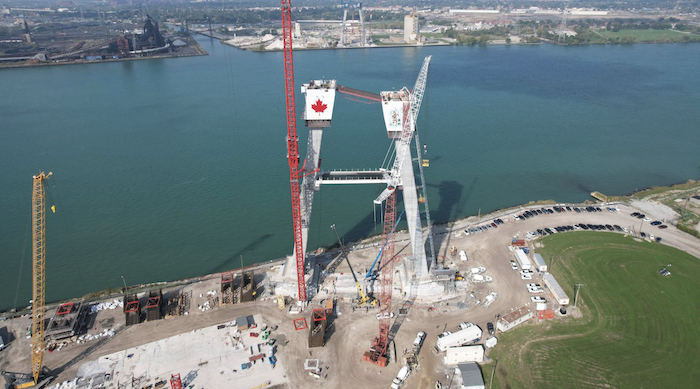
2022 #CCEawards Showcase: Gordie Howe International Bridge Environmental Management Program
November 7, 2022
By CCE
“This system will be instrumental in meeting commitments and mitigating environmental impacts for a highly complex project involving multiple stakeholders in two countries.” – Jury
Category: Special Projects
Ambassador Award and Award of Excellence Winner: AECOM
AECOM, as a member of Bridging North America (BNA) and working on behalf of the Windsor-Detroit Bridge Authority (WDBA) and the Michigan Department of Transportation (MDOT), is lead designer for the $5.7-billion Gordie Howe International Bridge project. At 2.5 km long and with a main span of 853 m, the structure itself will be the longest cable-stayed bridge in North America and one of the largest in the world.
Within the scope of its assignment, AECOM developed a cross-border environmental management system (EMS) to meet both Canadian and American regulatory requirements and integrate with the project’s quality, health, safety, security and sustainability systems. This is one of the first public-private partnership (P3) projects in Canada to achieve International Organization for Standardization (ISO) 14001:2015 certification.
The program includes 40 environmental plans in 10 disciplines and provides a mechanism to manage and monitor all environmental works. It assures agencies, stakeholders and the public that WDBA will meet its environmental commitments throughout design and construction.
AECOM’s environmental responsibilities for the project have included facilitating interagency and interdisciplinary consultation and co-ordination, securing permits and obtaining approvals from key federal, provincial, state, regional and local agencies.
Multidisciplinary management
Used during design and construction to mitigate environmental impacts and ensure regulatory compliance, the EMS involves monthly reporting to WDBA and discipline-specific management and monitoring plans that address site, project and regulatory details from several jurisdictions.
An interdisciplinary environmental management plan (EMP) provides the framework. The EMP includes customized checklists that were communicated to design leads early and monitored throughout the project for seamless integration and to minimize changes.
Comprehensive constraint maps were developed for both countries to characterize environmental features. Environmental obligation matrices were created to ensure regulatory and project agreement commitments were incorporated into plans and procedures. These matrices outline requirements and define how they will be managed through training, monitoring, inspections, audits and 22 discipline-specific environmental management and mitigation plans (EMMPs) that specify roles, responsibilities, authorities, competencies, resources, equipment, procedures, operational controls, compliance, mitigation, notifications, reporting and record-keeping.
The EMMPs cover:
- Air quality – Controlling fugitive emissions generated during construction and addressing ongoing air-quality monitoring.
- Noise and vibration – Monitoring and addressing pre-construction, construction and post-construction noise and vibration levels for sensitive receptors and providing procedures to support compliance with relevant guidelines.
- Hazardous material and waste management and spill prevention and response – Addressing the use and handling of materials to manage and reduce risks to human health and the natural environment during construction.
- Sediment and erosion control, groundwater, dewatering and excavated materials – Addressing sedimentation, erosion and contamination controls to protect the Detroit River and nearby resources.
- Vegetation, invasive species, wildlife, species-at-risk (SAR) and aquatic resources – Providing information and protocols to protect aquatic and terrestrial species, contain and control weeds and minimize natural heritage impacts during construction.
- Archaeology and cultural heritage resources – Defining protocols if unanticipated archaeological materials or human remains are discovered during construction and outlining measures for protecting known cultural heritage resources.
The project also incorporates environmentally sound innovations aimed at meeting Envision and LEED Silver requirements and prescribed energy targets during a 30-year operations and management (O&M) period.
EMS technical reporting is interconnected among the project’s technical working groups (TWGs) through Autodesk’s BIM 360 construction management software platform, where field data is collected and made available in real time using collaboration tools like Bentley Systems’ ProjectWise, Microsoft’s SharePoint, Trimble’s e-Builder and the project’s own environmental performance trackers. These tools enable simultaneous interdisciplinary reviews to promptly identify issues, inform decision-making and ensure compliance throughout design and construction.

Environmental management and mitigation plans (EMMPs) address species-at-risk, vegetation and aquatic resources. Photo courtesy AECOM.
A complex process
Establishing the EMS was a complex process, as it needed to satisfy environmental regulations for Canada, the U.S., Ontario and Michigan. The project not only encompasses the bridge itself, but also the Canadian and U.S. ports of entry and Michigan’s I-75 Interchange. The EMS also follows requirements of various environmental assessments that were completed in the project’s planning stage, which spanned more than a decade. Consolidation of these requirements was achieved through the obligations matrices.
Given the complex regulatory nature of this international project, the audit program was intricate. To simplify and optimize the process, compliance audits were phased across the assessment period, with site tours scheduled to allow observations when the most relevant field activities were underway.
Further, the design project team spans 36 offices, with more than 20 subconsultants and a globally dispersed team of more than 500. A TWG meetings plan was developed and implemented to ensure the environmental commitments were incorporated as design progressed.
With the outbreak of COVID-19, the team quickly adapted to accommodate work from hundreds of home offices and implemented virtual audits to ensure there was no gap in the EMS implementation and associated compliance program.
Community benefits
Developing the transportation corridor in a socially and fiscally responsible fashion will support economic growth through tourism, trade and job creation. Federal, provincial, state, regional and local regulatory/permitting agencies, other stakeholders and the public all benefit from a project that meets environmental mitigation, permitting and other commitments.
While the EMS regulates and monitors environmental impacts during construction and mitigates disruption to local communities, it also addresses areas of cultural significance. It involves archaeological studies, for example, to prevent impacts to cultural heritage resources.
Between 2015 and 2019, a two-phase consultation approach was undertaken with Ontario and Michigan residents, Indigenous peoples, business owners and community and municipal leaders, resulting in more than 230 suggestions for community benefits. Priorities included workforce training strategies, community safety, esthetics, landscaping and community development.
Gordie Howe International Bridge Environmental Management Program, Detroit, Mich., and Windsor, Ont.
Award-winning firm (lead designer): AECOM, Mississauga, Ont. (Gilian Opolko, BSc; Andrea Peak, PE; Brian Kennedy, AICP; Peter Byrne, P.Eng.).
Owner: Windsor-Detroit Bridge Authority (WDBA).
Other key players: Bridging North America (client) and MDOT (WDBA project partner).
